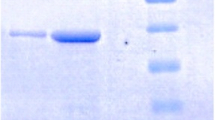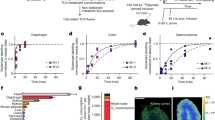Abstract
Mouse mammary carcinoma cells were exposedin vitro to increasing concentrations of doxorubicin hydrochloride [adriamycin (ADR)] or 5-fluorouracil (5-FU). Uptake of [75Se]selenomethionine (75SeM) in a methionine-deficient medium measured the resulting inhibition of protein synthesis by the tumour cells. This was compared with the ability of the75SeM labelled tumour cells to localize in mouse lungs and to form pulmonary tumours following intravenous (i.v.) injection into isogenic hosts. These parameters were also related to the ability of the drugs to inhibit pulmonary tumour formationin vivo when injected into mice which had received tumour cells i.v. Results from five different tumours were pooled for analysis. At the highest drug concentration (10μg/ml ADR, 100μg/ml 5-FU) inhibition of protein synthesis was significantly related to thein vivo action of the drugs in limiting formation of pulmonary tumours (P<0·02 using the rank difference coefficient). There was also a direct relationship between pulmonary localization of tumour cells following exposure to drugs, their ability to form tumour nodules (P<0·025) and thein vivo action of the drugs in inhibiting tumour formation (P<0·s05). Thus inhibition of protein synthesisin vitro and pulmonary localization following i.v. injection may be of value in predicting thein vivo effect of cytotoxic drugs.
Similar content being viewed by others
References
Alberts, D. C., andChen, M. S., 1980, Tabular summary of pharmacokinetic parameters relevant toin vitro drug assay.Progress in Clinical and Biological Research,48, 351–359.
Brooks, C. G., Rees, R. C., andRobbins, R. A., 1978, Studies on the microcytotoxicity test. II. The uptake of amino acids ([3H]leucine or [75Se]methionine) but not nucleosides ([3H]thymidine or [125I]IUdR) or51CrO 2−4 provides a direct and quantitative measure of target cell survival in the presence of lymphoid cells.Journal of Immunological Methods,21, 111–124.
Brooks, C. G., 1978, Studies on the microcytotoxicity test. III. Comparison of [75Se]selenomethionine with [3H]proline, Na2 51CrO4 and [125I] iododeoxyuridine for pre-labelling target cells in long-term cytotoxicity tests.Journal of Immunological Methods,22, 23–36.
Durrant, L. G., Garnett, M. C., Gallego, J., Armitage, N. C., Ballentyne, K. C., Marksman, R. A., Hardcastle, J. D., andBaldwin, R. W., 1987, Sensitivity of newly established colorectal cell lines to cytotoxic drugs and monoclonal antibody drug conjugates.British Journal of Cancer,56, 722–726.
Ford, T. C., Lai, T., andSymes, M. O., 1987, Morphological and functional characteristic of mouse mammary carcinoma cells separated on Nycodnez columns.British Journal of Experimental Pathology,68, 453–460.
Freshney, R. L., Paul, J., andKane, I. M., 1975, Assay of anticancer drugs in tissue culture; conditions affecting their ability to incorporate3H-leucine after drug treatment.British Journal of Cancer,31, 89–99.
Hamburger, A., andSalmon, S. E., 1977, Primary bio-assay of human tumour stem cells.Science,197, 461–463.
Hutchinson, G. H., Heinemann, D., Symes, M. O., andWilliamson, R. C. N., 1981, Differential immune reactivity of tumour-intrinsic and peripheral blood lymphocytes against autoplastic colorectal carcinoma cells.British Journal of Cancer,44, 396–402.
Ichihashi, H., Kondo, T., Sakakibara, S., Akiyama, S., andWatanabe, T., 1984, Application of radioactive precursors for the evaluation of sensitivity of cancer cells to anticancer drugs.Oncology,41, 88–95.
Jones, A. C., Stratford, I. J., Wilson, P. A., andPeckham, M. J., 1982,In vitro cytotoxic drug sensitivity testing of human tumour xenografts grown as multicellular tumour spheroids.British Journal of Cancer,46, 870–879.
Leibold, W., andBridge, S., 1979,75Se-release: a short and long term assay for cellular cytotoxicity.Zeitschrift für Immunitätsforschung,155, 287–311.
Roopol, C., Sips, H. C. M., Theunissen, J., Atassi, G., andBernheim, J. L., 1984,In vitro assessment of cytotoxic agents in murine cancers: comparison between antiprolife-rative and antimetabolic assays.Journal of the National Cancer Institute,72, 661–666.
Roper, F. R., andDrewinko, B., 1976, Comparison ofin vitro methods to determine drug-induced cell lethality.Cancer Research,36, 2182–2188.
Tennant, J. R., 1964, Evaluation of the trypan blue technique for determination of cell viability.Transplantation,2, 685–694.
Twentyman, P. R., 1980, Response to chemotherapy of EMT6 spheroids as measured by growth delay and survival.British Journal of Cancer,42, 297–304.
Twentyman, P. R., Walls, G. A., andWright, K. A., 1984, The response of tumour cells to radiation and cytotoxic drugs—a comparison of cologenic and isotope uptake assays.British Journal of Cancer,50, 625–631.
Umleby, H. C., Fermor, B., Symes, M. O., andWilliamson, R. C. N., 1984, Viability of exfoliated colorectal cancer cells.British Journal of Surgery,71, 659–663.
Van den Brenk, H. A. S., Burch, W. M., Kelly, H., andOrton, C., 1975, Venous diversion trapping and growth of blood-borne cancer cells en route to the lungs.British Journal of Cancer,31, 46–61.
Volm, M., Wayss, K., Kaufmann, M., andMattern, J., 1979, Pre-therapeutic detection of tumour resistance and the results of tumour chemotherapy.European Journal of Cancer,15, 983–993.
Weisenthal, L. M., Marsden, J. A., Dill, P. L., andMacaluso, C. K., 1983, A novel dye exclusion method for testingin vitro chemosensitivity of human tumours.Cancer Research,43, 749–757.
Author information
Authors and Affiliations
Rights and permissions
About this article
Cite this article
Lai, T., Stonebridge, B.R., Black, J. et al. Inhibition of protein synthesis, pulmonary localization and pulmonary tumour formation by drug-treated tumour cells as a means of predicting their chemosensitivity. Clin Exp Metast 7, 427–436 (1989). https://doi.org/10.1007/BF01753663
Received:
Accepted:
Issue Date:
DOI: https://doi.org/10.1007/BF01753663




